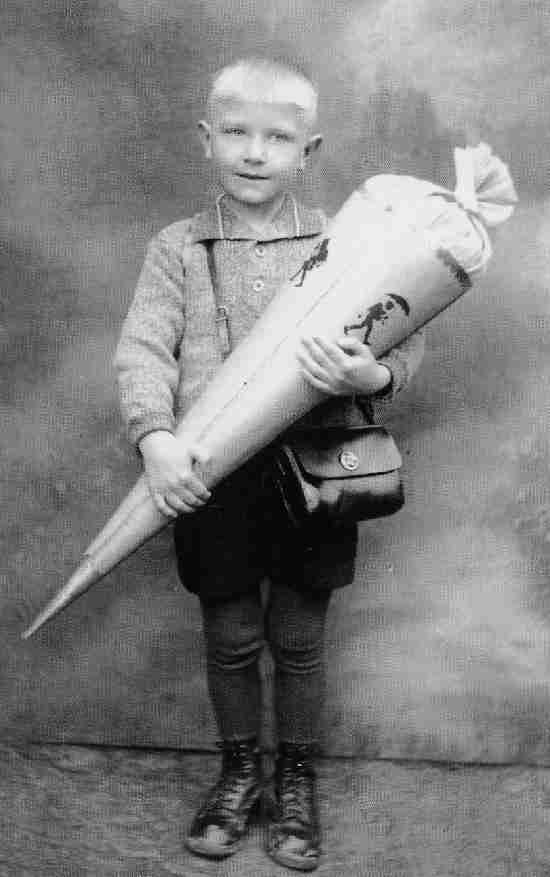
German Boys' Clothes: The Weimar Republic--School

Figure 1.-- This is a typical German boy set for his first day of school. The portrait was probably taken about 1925-30. I
don't know from what region, but I suspect Berlin since I found it in a
postcard shop with Berlin historical materials as the feature. Also notice the
typical cone of goodies given to entering school children, the lunch case
case worn on a strap around the neck, the short blonde hair worn in short
bangs, the knitted sweater with a collar, the dark shorts and dark long
stockings, and the hightop shoes.
|
Some of the most appealing snapshots and portraits taken during the 1920s were the obligatory photograph taken on a child's first day of school. The children are scrubbed clean, their hair combed and dressed in sturdy new school clothes. Thus these imnages represent a wonderful recird of what boys and girls were wearung at about 6 years of age. All are tightly holding onto their gift cones to get them interested in this important step in their lives. The practice declined during the NAZI-era, especially after the War began.
Germany's defeat in World War I (1914-18) brought about the abdicatin of the Kaisser and formation of the Weimar Republic. The disorders following the war,
economic dislaocation, and rampant imflation brought on terrible hardships with the German people. Despite the difficicilties, Germany still had arguably the finest educational system in Europe. German scgools, universitiesm and technical institutes guaranted a quality basic education to all and advanced educatioj to those able to pass competitive examinations. German schools after the First World War continued the policy of allowing boys to wear the clothes parents selected for them. Given the horrors of the First World War it is understandable that German parents would have little reason to develop an interest in uniforms for school children, although the War did not affect British opinions on uniforms. Interestingly, sailor suits continued to be a popular style for boys, including older boys than wore sailor suits--both with short and long pants. This varied from Britain and America where it became increasingly rare in the 1920s for older boys to wear them. A few boys also wore smocks, at least in the early 1920s. Most boys that didn't wear sailor suits, however, wore short pants suits of various designs.
It is a tradition on a child's first day of school in many countries to take a photograph. Sometimes this was done formally, but more common a snapshot was taken at home. The photographs show not only the child's clothing, but often book bags and even flowers or other gifts for the teacher. This tradition is less formal today, although children are much photographed than ever before. Some of the most appealing snapshots and portraits taken during the 1920s were the obligatory photograph taken on a child's first day of school. The children are scrubbed clean, their hair combed and dressed in sturdy new school clothes. Thus these imnages represent a wonderful recird of what boys and girls were wearung at about 6 years of age. All are tightly holding onto their gift cones ( Zuckertute / Schultüten ) to get them interested in this important step in their lives. The practice declined during the NAZI-era, especially after the War began. The portait here is a typical German boy about to begin his first day of school. The portrait was robably taken about 1925-30. I
don't know from what region, but I suspect Berlin since I found it in a
postcard shop with Berlin historical materials as the feature. Also notice the
typical cone of goodies given to entering school children, the lunch case
case worn on a strap around the neck, the short blonde hair worn in short
bangs, the knitted sweater with a collar, the dark shorts and dark long
stockings, and the hightop shoes.
HBU

Navigate the Boys' Historical Clothing German pages:
[Return to the Main German Weimar Republic chronology page]
[German choirs]
[Hitler Youth]
[German school uniforms]
[German royalty]
[German sailor suits]
[Lederhosen]
[Ethnic]
[Tights]
[Long stockings]
Navigate the Boys' Historical Clothing Web Site:
[Introduction]
[Activities]
[Biographies]
[Chronology]
[Clothing styles]
[Countries]
[Bibliographies]
[Contributions]
[FAQs]
[German glossary]
[Satellite sites]
[Tools]
[Boys' Clothing Home]
Created: September 11, 2003
Last updated: September 11, 2003



